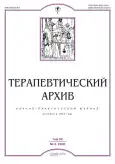Delayed coronary obstruction of the left main artery after transcatheter aortic valve replacement
- Authors: Komlev A.E.1, Lepilin P.M.1, Kurilina E.V.1, Romakina V.V.1, Imaev T.E.1
-
Affiliations:
- National Medical Research Center of Cardiology
- Issue: Vol 92, No 4 (2020)
- Pages: 70-75
- Section: Consensuns
- URL: https://journals.rcsi.science/0040-3660/article/view/34104
- DOI: https://doi.org/10.26442/00403660.2020.04.000466
- ID: 34104
Cite item
Full Text
Abstract
Coronary arteries’ obstruction associated with transcatheter aortic valve implantation (TAVI) may occur either during the procedure or after it. In the latter coronary obstruction can be further divided into early (<7 days after procedure) or delayed one (>7 days). Delayed coronary obstruction (DCO) is referred as a rare but devastating complication after TAVI and is associated with the extremely high mortality. This case demonstrates the objective difficulties of timely diagnostics of DCO. Since the results of non-invasive methods are indetermined in most cases, the authors conclude that even low-specific clinical symptoms must be interpreted as the definite rationale for the implementation of invasive diagnostic and treatment strategy.
Full Text
##article.viewOnOriginalSite##About the authors
A. E. Komlev
National Medical Research Center of Cardiology
Author for correspondence.
Email: pentatonika@bk.ru
ORCID iD: 0000-0001-6908-7472
кардиолог отд. сердечно-сосудистой хирургии
Russian Federation, MoscowP. M. Lepilin
National Medical Research Center of Cardiology
Email: pentatonika@bk.ru
ORCID iD: 0000-0003-2979-2542
к.м.н., сердечно-сосудистый хирург, ст. науч. сотр. отд. сердечно-сосудистой хирургии
Russian Federation, MoscowE. V. Kurilina
National Medical Research Center of Cardiology
Email: pentatonika@bk.ru
врач-патологоанатом
Russian Federation, MoscowV. V. Romakina
National Medical Research Center of Cardiology
Email: pentatonika@bk.ru
ORCID iD: 0000-0002-0035-0794
кардиолог отд. сердечно-сосудистой хирургии
Russian Federation, MoscowT. E. Imaev
National Medical Research Center of Cardiology
Email: pentatonika@bk.ru
ORCID iD: 0000-0002-5736-5698
д.м.н., сердечно-сосудистый хирург, гл. науч. сотр. отд. сердечно-сосудистой хирургии
Russian Federation, MoscowReferences
- Krasopoulos G, Falconieri F, Benedetto U, et al. European real world transcatheter aortic valve implantation: systematic review and meta-analysis of European national registries. J Cardiothorac Surg. 2016;11:159. doi: 10.1186/s13019-016-0552-6
- Barbanti M, Webb JG, Gilard M, et al. Transcatheter aortic valve implantation in 2017: state of the art. EuroIntervention. 2017;13:AA11-21. doi: 10.4244/EIJ-D-17-00567
- Vahl TP, Kodali SK, Leon MB. Transcathter aortic valve replacement 2016: A Modern-Day “Through the Looking-Glass” Adventure. J Am Coll Cardiol. 2016;67:1472-87. doi: 10.1016/j.jacc.2015.12.059
- Ribeiro HB, Nombela-Franco L, Urena M, et al. Coronary obstruction following transcatheter aortic valve implantation. JACC: Cardiovasc Interv. 2013;6(5):452-61. doi: 10.1016/j.jcin.2012.11.014
- Dvir D, Leipsic J, Blanke P, et al. Coronary obstruction in transcatheter aortic valve-in-valve implantation, preprocedural evaluation, device selection, protection, and treatment. Circ Cardiovasc Interv. 2015;8:e002079. doi: 10.1161/CIRCINTERVENTIONS.114.002079
- Dvir D, Webb J, Brecker S, et al. Transcatheter aortic valve replacement for degenerative bioprosthetic surgical valves: results from the global valve-in-valve registry. Circulation. 2012;126:2335-44. doi: 10.1161/CIRCULATIONAHA.112.104505
- Thomas M, Schymik G, Walther T, et al. Thirty-day results of the SAPIEN Aortic Bioprosthesis European Outcome (SOURCE) Registry: a European registry of transcatheter aortic valve implantation using the Edwards SAPIEN valve. Circulation. 2010;122:62-9. doi: 10.1161/ CIRCULATIONAHA.109.907402
- Stabile E, Sorropago G, Cioppa A, et al. Acute left main obstructions following TAVI. EuroIntervention. 2010;6:100-5. doi: 10.4244/ EIJV6I1A15
- Ribeiro HB, Webb JG, Makkar RR, et al. Predictive factors, management, and clinical outcomes of coronary obstruction following transcatheter aortic valve implantation: insights from a large multicenter registry. J Am Coll Cardiol. 2013;62:1552-62. doi: 10.1016/j.jacc. 2013.07.040
- Jabbour RJ, Tanaka A, Finkelstein A, et al. Delayed coronary obstruction after transcatheter aortic valve replacement. J Am Coll Cardiol. 2018;71(14):1513-24. doi: 10.1016/j.jacc.2018.01.066
- Buscaglia A, Tini G, Bezante GP, et al. Sudden death after valve-in-valve procedure due to delayed coronary obstruction: a case report. J Med Case Rep. 2018;12:247. doi: 10.1186/s13256-018-1785-x
- Toeg HD, Labinaz M, Hudson C, Ruel M. Aortic valve cusp shearing and migration into the left main coronary artery during transcatheter aortic valve implantation. Can J Cardiol. 2012;28(5):611.e1-3. doi: 10.1016/j.cjca.2012.03.006
- Ye J. Coronary Artery Occlusion as a Complication of Transcatheter Aortic Valve Implantation. Can J Cardiol. 2012;28(5):534-36. doi: 10.1016/j.cjca.2012.03.015
- Komatsu I, Mackensen GB, Aldea GS, et al. Bioprosthetic or native aortic scallop intentional laceration to prevent iatrogenic coronary artery obstruction. Part 1: how to evaluate patients for BASILICA. EuroIntervention. 2019;15:47-54. doi: 10.4244/EIJ-D-19-00057
Supplementary files
















